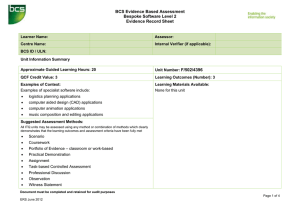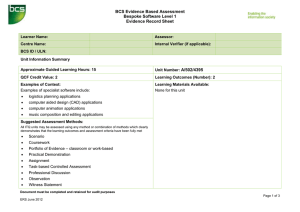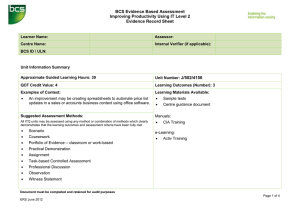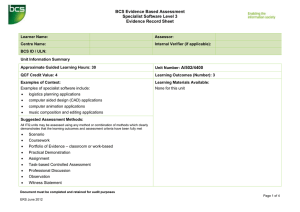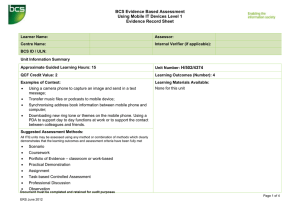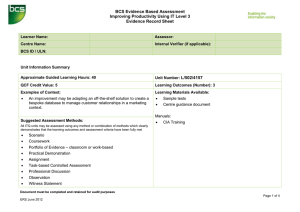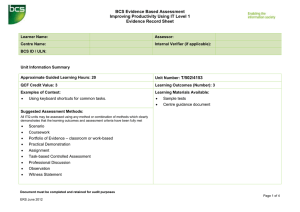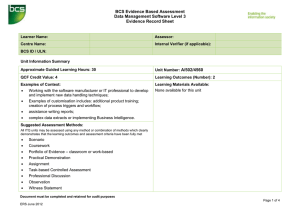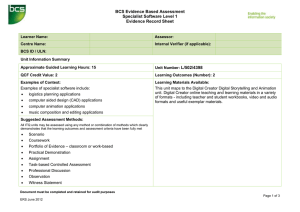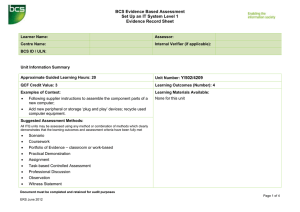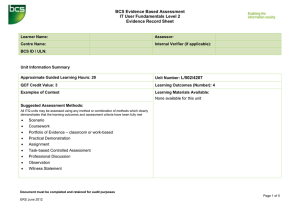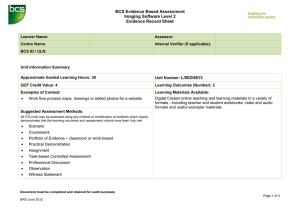BCS Evidence Based Assessment Bespoke Software Level 3 Evidence Record Sheet
advertisement
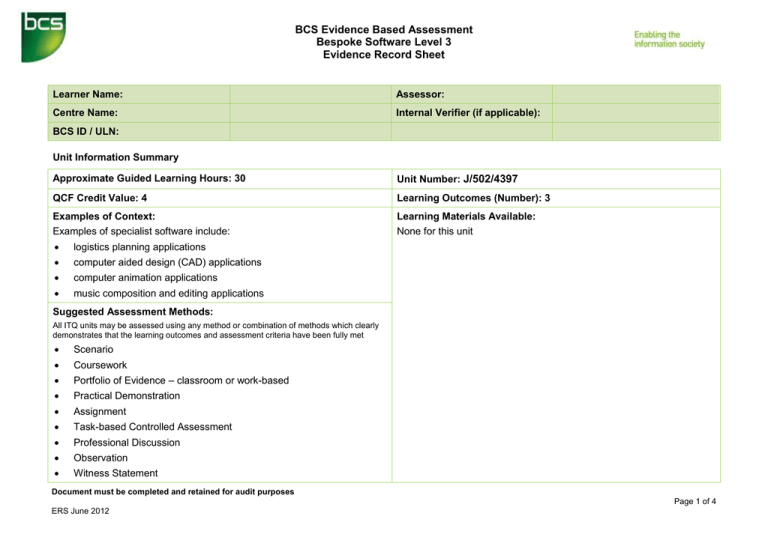
BCS Evidence Based Assessment Bespoke Software Level 3 Evidence Record Sheet Learner Name: Assessor: Centre Name: Internal Verifier (if applicable): BCS ID / ULN: Unit Information Summary Approximate Guided Learning Hours: 30 Unit Number: J/502/4397 QCF Credit Value: 4 Learning Outcomes (Number): 3 Examples of Context: Examples of specialist software include: Learning Materials Available: None for this unit logistics planning applications computer aided design (CAD) applications computer animation applications music composition and editing applications Suggested Assessment Methods: All ITQ units may be assessed using any method or combination of methods which clearly demonstrates that the learning outcomes and assessment criteria have been fully met Scenario Coursework Portfolio of Evidence – classroom or work-based Practical Demonstration Assignment Task-based Controlled Assessment Professional Discussion Observation Witness Statement Document must be completed and retained for audit purposes Page 1 of 4 ERS June 2012 BCS Evidence Based Assessment Bespoke Software Level 3 Evidence Record Sheet Ofqual Learning Outcome Assessment Criteria 2 Create and modify appropriate structures to organise and retrieve information efficiently Evidence Location The examples given are indicative of the learning content at each level and are not intended to form a prescriptive list for the purpose of assessment 1.1 1 Input and combine information using bespoke software Examples of Content Input relevant information accurately so that it is ready for processing Types of bespoke information: Information will vary according to the software for example, text, numbers, photos, scanned images, graphic elements, digital recorded sound, graphs, charts, tables Inputting information: Inputting tools and techniques will vary according to the technology being used: for example, interface devices (eg keyboard, mouse, stylus, touch screen), microphone (eg headset, built-in), camera (eg web cam, video camera, mobile phone camera); shortcuts, customise keys 1.2 Select and use appropriate techniques to link and combine information within the application and across different software applications Combining information techniques: Insert, size, position, wrap, order, group; import data, links and references to external data, version control; export data File types and software: Text (eg rtf, doc, pdf), images (eg jpeg, tiff, psd), charts and graphs (eg xls), sound (eg wav, MP3) 2.1 Evaluate the use of software functions to structure, layout and style information 2.2 Create, change and use appropriate structures and/or layouts to organise information efficiently Structures, layouts and conventions: Apply and change existing templates, set up templates for common information, apply or change existing styles, set up styles for information 2.3 Manage data files effectively, in line with local and/or legal guidelines and conventions for the storage and use of data where available Manage data files: File storage, data import and export, restore lost data; identify ineffective backup storage Guidelines for the storage and use of data: Set by employer or organisation. Policies relating to security, backup and data protection; guidelines for data format; compliance, audit and reporting requirements File management will vary according to the application. Document must be completed and retained for audit purposes Page 2 of 4 ERS June 2012 BCS Evidence Based Assessment Bespoke Software Level 3 Evidence Record Sheet Ofqual Learning Outcome Assessment Criteria Examples of Content Evidence Location The examples given are indicative of the learning content at each level and are not intended to form a prescriptive list for the purpose of assessment 3.1 Select and use appropriate tools and techniques to edit, analyse and format information Editing, analysis and formatting techniques: Techniques will vary according to the software and task, for example: Editing – select, insert, delete, cut, copy, paste, drag and drop, find, replace, page layout, labelling, alignment, orientation, colour, resolution, size, pitch Analysis – design queries, mathematical, logical or statistical functions 3 Exploit the functions of the software effectively to process and present information Formatting – characters, lines, paragraphs, pages, file type 3.2 Check information meets needs, using IT tools and making corrections as necessary Check information: Checks will vary according to the type of information and software, but could include: spell check, grammar check, accuracy of figures, labelling and size of images, volume of sound, quality of images and sound, that line, paragraph and page breaks fall appropriately, formatting is consistent, the use of headings and subheadings aid clarity, the placing of images or sound clips 3.3 Identify and respond appropriately to quality problems to ensure that outcomes are fit for purpose and meet needs Quality problems with outcomes: Will vary according to the content, for example, text (eg formatting, structure), images (eg size, position, orientation), numbers (eg decimal points, accuracy of calculations), sound (eg volume, sound clip out of sync) 3.4 Select and use presentation methods to aid clarity and meaning Presentation methods: Methods will vary according to the software and task, for example, on screen display, publishing on a web site, hard copy print out, digital file; organisational house style, branding Document must be completed and retained for audit purposes Page 3 of 4 ERS June 2012 BCS Evidence Based Assessment Bespoke Software Level 3 Evidence Record Sheet Assessment Report Assessor feedback / comments (continue on additional sheet / assessment report if necessary) Internal Verifier actions / comments / feedback Assessor signature: Assessment date: Reason for IV: New Assessor Random Sample IV signature: IV date: New Unit/Qualification Other Document must be completed and retained for audit purposes Page 4 of 4 ERS June 2012
